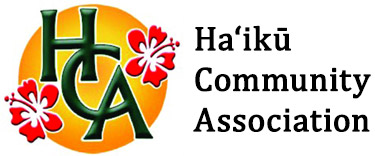Haiku/Paia Residents Question Water Use Plan
Maui’s long-in the-making Water Use and Development Plan (WUDP) left Haiku and Paia residents with more questions than answers after a two-hour Haiku Community Association (HCA) Town Hall discussion Thursday.
The online meeting, broadcast on Facebook, attracted almost 1,000 viewers who watched presentations from Maui Department of Water Supply’s Jeff Pearson and Eva Blumenstein about the strategy outlined in the 1,200-page WUDP to drill wells in the Haiku aquifer to supply the future water needs of Central and South Maui.
Moderator Dick Mayer asked questions gathered from community residents. Among primary concerns:
- The WUDP was created without data on the actual amount of water available in the Haiku aquifer. The plan’s assumptions that 8 million gallons per day could be sent from Haiku to South and Central Maui without impact are unproven.
- No studies have been conducted on the aquifer’s overall water quality, which lies below lands contaminated by pesticides used in pineapple cultivation.
- Some 400 Haiku residents are still waiting for water meters. Others who have installed private wells or who use springs are concerned about the impact large County wells will have on those resources. The plan did not appear to have guarantees that Haiku residents will have adequate access to water resources before well water is removed from the region.
- Traditional practitioners worry that the plan does not address potential impacts to streams, or to the interconnection of fresh water and the ocean, which is critical to taro farming and limu harvesting. Others voiced concern that the plan doesn’t take into account future growth of farming in Haiku.
Water Department planning program manager Eva Blumenstein reiterated that 51 meetings had been held on the WUDP—though none in Haiku—and said she was “sorry that Haiku feels left in the dark.”
But she had no specific answers to the community’s questions. “This is not a master plan for development,” she said. “It’s a guide to the council and county agencies.”
Blumenstein acknowledged that “where development is, is not where the water resources are,” and that the WUDP had “many unknowns. We tried to address water conflicts, but these aren’t easy solutions.” Later she conceded, “There’s really no one way to know exactly what the impact [of drilling wells in Haiku] is going to be,” adding that there were “methods and tools” that could be used to “mitigate scenarios.”
HCA president Lucienne de Naie told the Water Department officials that she had been attending water meetings for almost two decades. “Why we don’t have some studies after 17 years?” She added that she was “disgusted” to hear of people “waiting 30 years for a meter.”
Participant Shay Chan Hodges, chair of the Board of Water Supply which advises the Water Department, called the WUDP “gigantic” and suggested that future plans be synthesized “for a lay person.”
The people “want a voice in their own community’s development,” County Council member Mike Molina commented, referring to a bill under consideration to create a Haiku/Paia Community Plan advisory committee.
Molina suggested that, instead of voting to pass the WUDP, which is scheduled before the Maui County Council on October 9, the Council could decide that it needs to go back to committee for more work. ”I’m all for that.” He added. “I personally believe we need a plan that is fair to the community, limits diversion and takes advantage of other resources.”
He urged those watching to attend the online County Council hearing and share their views on October 9th.
Joyclynn Costa, who heads the Aha Moku Council for the Hamakualoa Moku, told Blumenstein and Pearson, “Haiku doesn’t have a [water] problem. You’re bringing a problem to Haiku. Ask Haiku for help and let’s work this out together and find a solution.”
